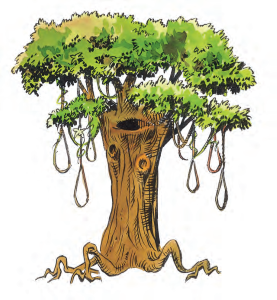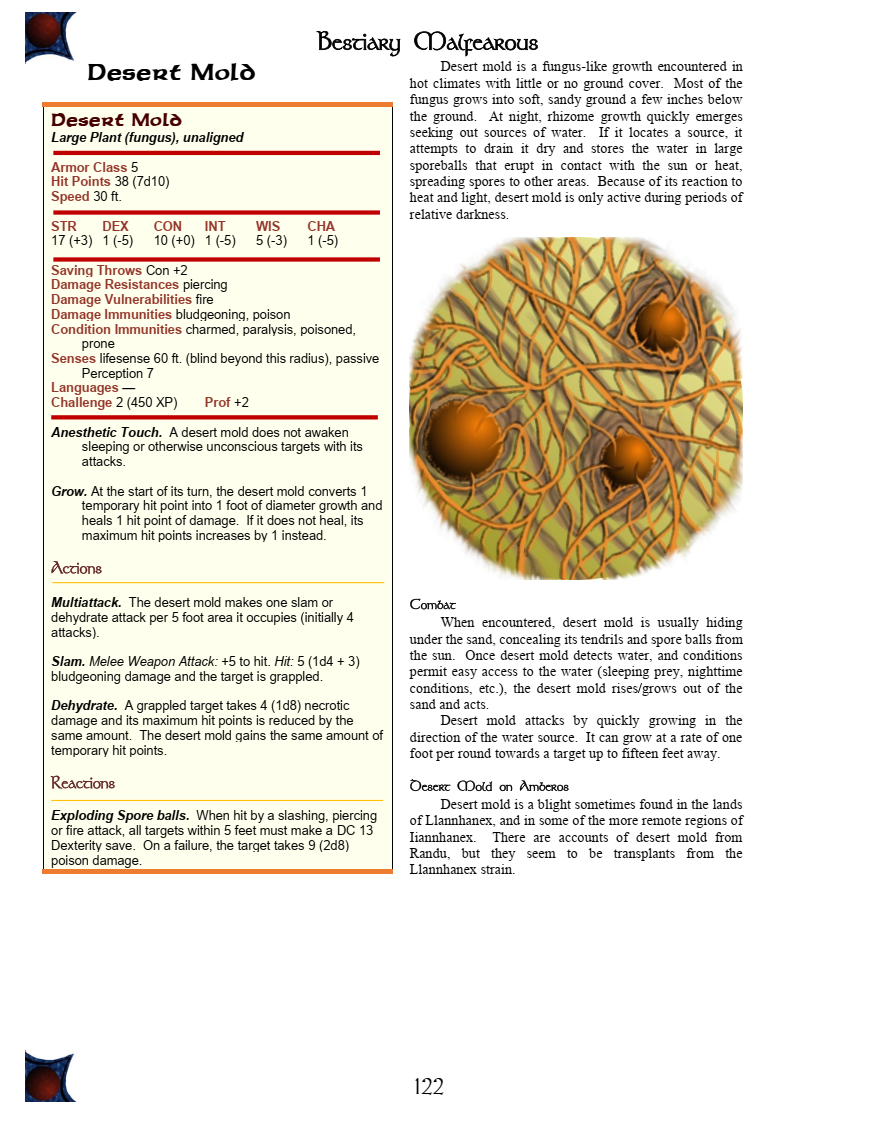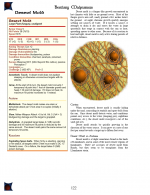You are using an out of date browser. It may not display this or other websites correctly.
You should upgrade or use an alternative browser.
You should upgrade or use an alternative browser.
D&D General Plants (and Fungi) that should be in your D&D Campaign!
- Thread starter BookTenTiger
- Start date
BookTenTiger
He / Him
I loooooove the idea of a cactus snake!I saw a crawling cactus at the Cal State Botanical Gardens in Berkeley. Also known as a creeping devil, this columnar cactus "crawls" across the desert floor by growing at one end while dying at the other end. In real life this happens at the pace of plant growth but I see no reason we couldn't make it faster and more vampiric.
BookTenTiger
He / Him
This is a very appropriate post for a thread necromancy!

(photo credit: M.Y. SITI-MUNIRAH, science news.com)
Fairy Lantern Flowers are parasitic plants that spend decades underground, feeding off of the roots of other plants. They lack the ability to photosynthesize, but still require pollination, so they emerge every once in a while to attract insects. They have strange, tentacle-like pedals and brightly colored insides.
In a D&D campaign, Fairy Lantern Flowers could require pollinators from the Faerie Realms. They spend decades beneath the ground, feeding from the roots of trees (which will then grow sickly or warped into strange, almost humanoid shapes), then rise on long stalks, almost floating into the air and glowing. Their long tendrils open portals into Faerie Realms and summon strange creatures to collect their pollen. Patient faeries keep track of the life cycles of Fairy Lantern Flowers and use these opportunities to make quick jaunts into Mortal Realms, gathering treasure or servants and leaping back to their home worlds before the flowers retreat to beneath the soil. Mages and druids seek out trees with the signature warp of the parasitic flowers and await their blooming, planning out ways to worship, trick, or even trap the faeries that pass through!
(photo credit: M.Y. SITI-MUNIRAH, science news.com)
Fairy Lantern Flowers are parasitic plants that spend decades underground, feeding off of the roots of other plants. They lack the ability to photosynthesize, but still require pollination, so they emerge every once in a while to attract insects. They have strange, tentacle-like pedals and brightly colored insides.
In a D&D campaign, Fairy Lantern Flowers could require pollinators from the Faerie Realms. They spend decades beneath the ground, feeding from the roots of trees (which will then grow sickly or warped into strange, almost humanoid shapes), then rise on long stalks, almost floating into the air and glowing. Their long tendrils open portals into Faerie Realms and summon strange creatures to collect their pollen. Patient faeries keep track of the life cycles of Fairy Lantern Flowers and use these opportunities to make quick jaunts into Mortal Realms, gathering treasure or servants and leaping back to their home worlds before the flowers retreat to beneath the soil. Mages and druids seek out trees with the signature warp of the parasitic flowers and await their blooming, planning out ways to worship, trick, or even trap the faeries that pass through!
Here's a zygomind from one of the Pathfinder Bestiaries:A while back, I saw one of these growing near my classroom:
View attachment 156285
(Photo Credit: wikimedia)
It's called a Latticed Stinkhorn or Red Cage. It's a very cool fungus. It starts as a white egg-like thing, then erupts into this cage structure.
It pretty much looks like a much larger version of the terrestrial fungus depicted above.
Johnathan
R_J_K75
Legend
Yeah, I think it was in one of the Monstrous Compendium Annuals towards the tail end of AD&D 2EWasn't there a hangman's tree someplace.
EDIT I was wrong apparently its been in 1E, 2E and 4E

Hangman tree
The hangman tree, also commonly known as a gallows tree,[1] was a rare species of sentient, carnivorous trees found most commonly in temperate to subtropical climates.[1][3] These trees resembled thick oaks, but with few branches, sparse foliage, and shallow root systems.[1][3] Knot-like...
jdrakeh
Front Range Warlock
My friend (and former DM) introduced Fungar, God of Fungus, to our first D&D 5e campaign. He was worshipped by cultists who infected live victims with spores ostensibly cultivated from the God of Fungus himself, where they would eventually turn the victims into fungal zombies whom the cultists could use to spread Fungar's influence.
RealAlHazred
Frumious Flumph (Your Grace/Your Eminence)
When it comes to weird fungi-related religious rituals, I really liked the ideas presented in “The Demonomicon of Iggwilv: Zuggtmoy: Queen of Fungi” by James Jacobs in Dragon #337. The picture presented was perfect: Zuggtmoy (or Tsuggtmoy, as she sometimes shows up in Gary's notes) as the patron of degerate, crazed swamp-people is absolutely perfect to inject a bit of Slasher Movie horror into your D&D.
BookTenTiger
He / Him
We're back!

(Photo credit: sciencenews.com)
E Muscae is a fungus that infects flies and always kills them at sundown. The infected fly climbs a high plant and glues its mouthparts to the stem. Then at sundown it opens its wings and dies.
There's a theory that the fungus always kills at sundown so that it can start producing spores at night and avoid the heat of the day.
In a D&D campaign, there could be a necrotic fungus that is dormant during the day, but at night turns people into ravenous zombies! The characters have to figure out how to avoid killing their infected friends and friendly NPCs and find a cure (or the source) of this fungus.
I love the idea of a town full of friendly folk who suddenly sprout mushrooms from their heads and go on killing rampages at night, then wake with no memories. "Huh, I wonder where those travelers went... They were so friendly (burrrp)."
(Photo credit: sciencenews.com)
E Muscae is a fungus that infects flies and always kills them at sundown. The infected fly climbs a high plant and glues its mouthparts to the stem. Then at sundown it opens its wings and dies.
There's a theory that the fungus always kills at sundown so that it can start producing spores at night and avoid the heat of the day.
In a D&D campaign, there could be a necrotic fungus that is dormant during the day, but at night turns people into ravenous zombies! The characters have to figure out how to avoid killing their infected friends and friendly NPCs and find a cure (or the source) of this fungus.
I love the idea of a town full of friendly folk who suddenly sprout mushrooms from their heads and go on killing rampages at night, then wake with no memories. "Huh, I wonder where those travelers went... They were so friendly (burrrp)."
Stormonu
NeoGrognard
There's a fungus that that does something similar to other insects and arthopods - infects them and turns them into a sort of zombie. I think D&D's Yellow Musk Creeper and zombie is based off it.
Along those lines and the "creeping cactus", this creature from my own Bestiary should give PCs the creeps. It'll grow over sleeping subjects, restraining and sapping them of water, leaving them as dried-out husks by morning...

Along those lines and the "creeping cactus", this creature from my own Bestiary should give PCs the creeps. It'll grow over sleeping subjects, restraining and sapping them of water, leaving them as dried-out husks by morning...
Attachments
I updated much of this in a product on DMsguild, which is a mediocre product and I tried some things with statblock that didn't work like I wanted. I really recommend these articles, most of them are well written and offers stuff for any campaign.There were a few good system neutral articles providing plants in old Dragon magazines:
Aside from the ones that are based on just awful puns, there are some cool ideas in there!
- "Wounds and Weeds" by Kevin J. Anderson (#82) gave some healing rules and descriptions of twelve real-world herbs: Aaron's rod, adder's-tongue, birthwort, comfrey, garlic, henbane, herb true-love, juniper berry, marsh-mallow, St.-John's-wort, sphagnum moss, and woundwort.
- "The Legacy of Hortus" by Jack Crane (#87) provided descriptions of fifteen fanciful animal-plant hybrids: beebalm, butterfly flowers, catnip, cobra orchids, cowslips, dandelions, foxglove, horehound, lambs ear, parrot tulips, smartweed, snake vine, snap dragons, tiger lilies, and wormwood.
- "The Plants of Biurndon" by Eric W. Pass (#108) gives descriptions of thirteen trees and herbs from the author's home campaign: sticktree, rivertree, papertree, medicinetree, redtree, natertree, lenthal, graveolens, boneset, redoil, angelica, blue tonic, and felamour.
- "The Ecology of Carnivorous Plants" by Gregg Chamberlain (#137) covers carnivorous plants in both the real world and in gaming; he doesn't provide any new plants, but discusses the carnivorous plants in various AD&D books.
- "The Dragon's Bestiary" by Gregg Chamberlain (#167) has AD&D stats for eight monstrous plants: giant bladderwort, giant butterwort, giant rainbow plant, giant waterwheel plant, swordgrass, clubfern, bloodflower, and hellborn.
- "The Dragon's Bestiary: Bad Seeds" by Ed Bonny, Skip Williams, and Steve Winter (#292) has seven plant/fungus monsters: death’s head tree, greenvise, myconid, needleman, orcwort, wortling, and red sundew.
- "Arcane Botanica" by Noel Scott (#357) talks about twelve new magical plants: djinn blossoms, nahre lotus, orevine, salamander orchids, aelfengrape, coldwood, fey cherry, flame clove, glowvine, lakeleaf, lichbriar, and tahtoalehti (aka, wishfern).
Similar Threads
- Replies
- 0
- Views
- 440
D&D General
Monster ENCyclopedia: Myconid
- Replies
- 7
- Views
- 22K
- Replies
- 166
- Views
- 105K
D&D General
Monster ENCyclopedia: Vrock
- Replies
- 30
- Views
- 21K
D&D General
Monster ENCyclopedia: Will-o'-wisp
- Replies
- 35
- Views
- 19K

